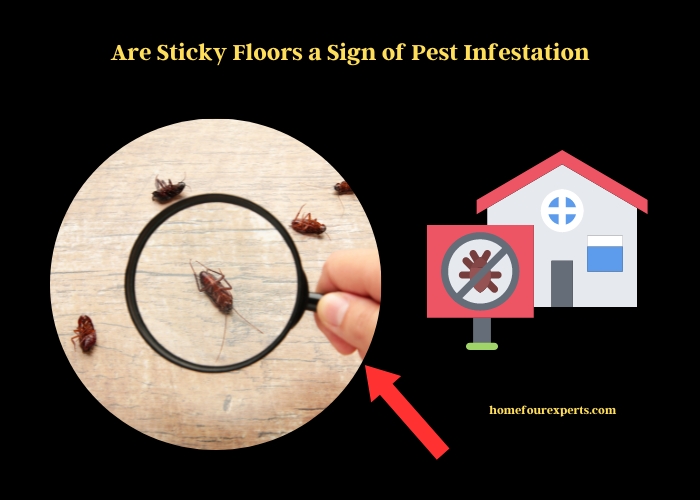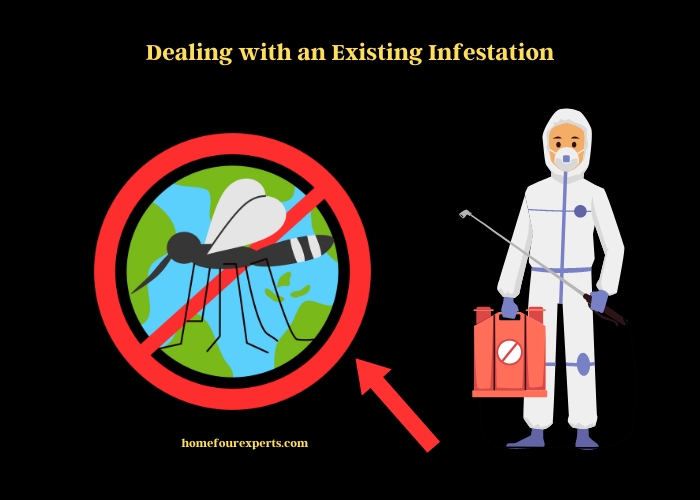Published on: September 18, 2022
Written by Eric Devin / Fact-checked by David Rowan
Sticky floors can be an indicator of pest infestation. Many pests like ants, cockroaches, and rodents are attracted to food residues, sugary spills, or other organic materials found on floors.
Sticky floors are a common issue in many households, and it is not always linked to a lack of cleanliness. Sometimes, even the most diligent cleaning efforts can still leave behind microscopic particles that attract pests. These critters, especially ants and cockroaches, are drawn to the scent of food residues, which can lead to a full-blown infestation. Moreover, dust can also be a sign of pest activity.
Pests like dust mites thrive in dusty environments, and a dusty home can be a breeding ground for them. Similarly, signs of pest infestation in food include small holes in packaging, live insects, and droppings. In the kitchen, besides sticky floors, other signs of infestation include gnaw marks on food containers, droppings, and a foul odor, which is often associated with a large number of pests.
Spotting any of these signs warrants immediate action to prevent further damage and health risks. To know more about identifying and dealing with pest infestations, read the detailed article below.

Sticky Floors: A Sneaky Sign of Pest Infestation?
You might think that sticky floors are just a sign of spilled juice or soda that wasn’t cleaned up properly, right? Well, it’s time to think again. Having sticky floors can indeed be a sign that you have unwelcome visitors in your home – pests.
The Connection Between Sticky Floors and Pests
Why are pests attracted to sticky floors? Pests like ants, cockroaches, and rodents are drawn to the scent of food residues. Even the tiniest particles of food can attract these critters. Once they find a reliable source of food, they can decide to set up camp, leading to a full-blown infestation.
Why Pests are Attracted to Sticky Floors
Sticky floors usually result from spills of sugary liquids, and as we all know, sugar is a big attractant for many pests. Ants, for example, have a keen sense of smell and can detect sugar from a distance. Once they locate a source, they leave a pheromone trail for other ants to follow, leading to a trail of ants marching across your floor.
Common Pests Associated with Sticky Floors
Ants and cockroaches are the most common pests associated with sticky floors. However, other pests like rodents can also be attracted to the residue on your floors. Rodents have an acute sense of smell and can detect food particles from a considerable distance.
Signs of Pest Infestation
Knowing the signs of pest infestation is crucial for early intervention. If you notice any of these signs, it’s time to take action.
In the Kitchen
Gnaw Marks on Food Containers
Finding gnaw marks on food containers is a clear sign that rodents have been in your kitchen. Rodents have sharp teeth and can chew through almost anything, including plastic and cardboard.
Droppings
Finding droppings in your kitchen is another clear sign of an infestation. Different pests produce different types of droppings. For example, mouse droppings are small and pellet-like, while cockroach droppings resemble coffee grounds.
Foul Odor
A foul odor is often associated with a large number of pests. This smell is usually caused by their droppings or, in severe cases, deceased pests that have started to decay.
In Food
Small Holes in Packaging
Finding small holes in the packaging of your food is a sign that pests have been helping themselves to your pantry. Insects like moths and beetles can chew through paper and plastic packaging.
Live Insects
Finding live insects in your food is a sure sign of an infestation. Insects like weevils and beetles can infest grains and other pantry items.
Other General Signs
Dust Accumulation
A dusty home can be a breeding ground for pests like dust mites. Regular cleaning and dusting can help prevent an infestation.
Insect Infestation Examples
Different insects leave behind different signs. Knowing what to look for can help you identify the type of infestation you are dealing with.
Different Insects and the Signs They Leave Behind
Cockroaches leave behind droppings that resemble coffee grounds. They can also leave behind a musty odor. Ants, on the other hand, leave behind a pheromone trail that other ants follow. This trail is usually invisible to the human eye, but if you see a line of ants marching across your floor, you know they have found a food source.
The Meaning Behind Pest Infestation
Pest infestations are more than just an inconvenience. They can have serious implications for your health and your wallet.
Health Risks Associated with Pest Infestation
Pests like cockroaches, rodents, and mosquitoes can carry diseases that are harmful to humans. Cockroaches can carry bacteria like E. coli and salmonella on their bodies, while rodents can spread diseases like hantavirus and leptospirosis.
Economic Implications of an Infestation
Dealing with a pest infestation can be costly. You may need to hire a professional pest control service, and in severe cases, you may need to replace furniture or even renovate your home.
Preventing Pest Infestations
Prevention is always better than cure. Here are some tips to help prevent a pest infestation.
Regular Cleaning and Maintenance
Keeping your home clean and well-maintained is the first step in preventing a pest infestation. Regularly clean your floors, countertops, and pantry shelves. Also, make sure to seal any cracks or holes in your walls or windows.
Proper Food Storage
Store food in airtight containers to prevent attracting pests. Also, make sure to regularly check your pantry for any signs of infestation.
Use of Natural Repellents
Natural repellents like peppermint oil and diatomaceous earth can help keep pests at bay. However, these are just preventative measures and may not be effective if you already have an infestation.
Dealing with an Existing Infestation

If you already have an infestation, it’s important to act quickly to prevent further damage.
Natural Remedies
Natural remedies like diatomaceous earth and boric acid can be effective against certain pests. However, it’s always best to consult a professional before using any products.
Chemical Solutions
There are many chemical solutions available on the market. It’s essential to choose one that is suitable for the type of infestation you have. Also, always follow the manufacturer’s instructions carefully.
When to Call a Professional
If the infestation is severe or if you are unsure of what to do, it’s always best to call a professional pest control service. They have the experience and the tools necessary to deal with the infestation effectively.
Comparison Tables
Common Pests and Their Attractants
| Pest | Attractant |
| Ants | Sugary substances, food residues |
| Cockroaches | Food residues, water, shelter |
| Rodents | Food, shelter |
Signs of Infestation and Possible Culprits
| Sign | Possible Culprit |
| Gnaw marks on food containers | Rodents |
| Droppings | Rodents, cockroaches |
| Foul odor | Large number of pests, decaying pests |
Pest Infestation Calculator
Here is a simple calculator to estimate the risk of a pest infestation based on certain parameters like cleanliness, food storage, etc.
Pest Infestation Risk Calculator
FAQs
Is Sticky Floors a Sign of Pest Infestation?
Yes, sticky floors can be a sign of pest infestation. Pests like ants, cockroaches, and rodents are attracted to food residues, and sugary substances that cause stickiness on floors. Therefore, having sticky floors can indicate that you might have unwelcome visitors in your home.
What Is Not a Sign of Pest Infestation?
Clean and well-maintained surfaces without any droppings, live insects, or gnaw marks are generally not signs of pest infestation. Additionally, absence of foul odor and dust accumulation are also indicators that your space is free from pests.
What Are the Signs of Pest Infestation in Food?
Signs of pest infestation in food include small holes in packaging, live insects, and droppings. Insects like weevils and beetles can infest grains and other pantry items, leaving behind visible traces of their presence.
Which Is Not a Sign of Possible Pest Infestation?
The absence of droppings, gnaw marks on food containers, live insects, foul odor, and dust accumulation are indicators that there is no pest infestation in your space. Additionally, if there are no lines of ants or visible trails of pests, it is unlikely that there is an infestation.
Does Finding Dead Insects or Mouse Droppings in the Kitchen Indicate an Infestation?
Yes, finding dead insects or mouse droppings in the kitchen is a strong indication of a pest infestation. Droppings and deceased pests are clear signs that pests have been present in your space.
What Is the Meaning of Pest Infestation?
Pest infestation refers to the presence of unwanted creatures like insects, rodents, and other pests in a space in large numbers. These pests can pose serious health risks, cause damage to structures, and contaminate food.
Can Proper Food Storage Prevent Pest Infestation?
Yes, proper food storage can help prevent pest infestation. Storing food in airtight containers prevents attracting pests and keeps them from accessing your food. Regularly checking your pantry for any signs of infestation is also crucial.
Summary
Pest infestations are more than just an inconvenience; they can pose serious health risks and have economic implications. Keeping your home clean and well-maintained is the first step in preventing an infestation. Proper food storage and the use of natural repellents can also help. However, if you already have an infestation, it’s important to act quickly. Natural remedies and chemical solutions can be effective, but in severe cases, it’s always best to consult a professional.
About This Writer

Hi, I am Eric Devin and I am a professional interior architect. Since childhood, I've always enjoyed DIY projects! And, I have loved to solve simple household problems using essential tools and equipment. I have also acquired a lot of information about basic household tools settings by working with contractors.